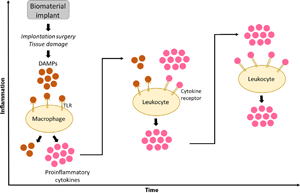Crossref Citations
This article has been cited by the following publications. This list is generated based on data provided by
Crossref.
Kharbikar, Bhushan N.
Chendke, Gauree S.
and
Desai, Tejal A.
2021.
Modulating the foreign body response of implants for diabetes treatment.
Advanced Drug Delivery Reviews,
Vol. 174,
Issue. ,
p.
87.
Capuani, Simone
Malgir, Gulsah
Chua, Corrine Ying Xuan
and
Grattoni, Alessandro
2022.
Advanced strategies to thwart foreign body response to implantable devices.
Bioengineering & Translational Medicine,
Vol. 7,
Issue. 3,
Liang, Luxin
Song, Deye
Wu, Kai
Ouyang, Zhengxiao
Huang, Qianli
Lei, Guanghua
Zhou, Kun
Xiao, Jian
and
Wu, Hong
2022.
Sequential activation of M1 and M2 phenotypes in macrophages by Mg degradation from Ti-Mg alloy for enhanced osteogenesis.
Biomaterials Research,
Vol. 26,
Issue. 1,
Zheng, Yan
Shi, Dunyun
and
Wang, Zheng
2023.
Anti-biofouling strategies for implantable biosensors of continuous glucose monitoring systems.
Frontiers of Chemical Science and Engineering,
Vol. 17,
Issue. 12,
p.
1866.
Grey, Emerson L.
McClendon, Jazalle
Suresh, Joshita
Alper, Scott
Janssen, William J.
and
Bryant, Stephanie J.
2023.
Thiol-Michael Addition Microparticles: Their Synthesis, Characterization, and Uptake by Macrophages.
ACS Biomaterials Science & Engineering,
Vol. 9,
Issue. 7,
p.
4223.
McKiel, Laura A.
Ballantyne, Laurel L.
Negri, Gian Luca
Woodhouse, Kimberly A.
and
Fitzpatrick, Lindsay E.
2023.
MyD88-dependent Toll-like receptor 2 signaling modulates macrophage activation on lysate-adsorbed Teflon™ AF surfaces in an in vitro biomaterial host response model.
Frontiers in Immunology,
Vol. 14,
Issue. ,
Androschuk, Alaura M.
Carleton, Miranda M.
Talior-Volodarsky, Ilana
and
Sefton, Michael V.
2023.
Methacrylic Acid-Based Regenerative Biomaterials: Explorations into the MAAgic.
Regenerative Engineering and Translational Medicine,
Vol. 9,
Issue. 1,
p.
4.
Callaghan, Neal I.
Rempe, Christian N.
Froom, Zachary S. C. S.
Medd, Kyle T.
and
Davenport Huyer, Locke
2024.
Cell dynamics and metabolism of the foreign body response: characterizing host-biomaterial interactions for next-generation medical implant biocompatibility.
Materials Advances,
Vol. 5,
Issue. 17,
p.
6719.




